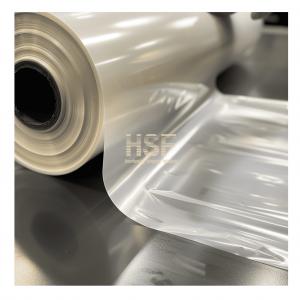

Add to Cart
<General production process of BOPP film>
1. Raw material selection and preparation:
Suitable polypropylene resin is carefully selected and pretreated
to remove impurities and moisture.
2. Extrusion:
The pretreated polypropylene resin is melted and processed through
extrusion to form a film of the desired thickness.
3. Orientation:
The extruded film is then stretched biaxially to improve its
strength and durability by orienting the molecular chains.
4. Heat setting:
The biaxially oriented film is then heat treated to stabilize its
size and properties, ensuring consistent quality.
5. Cooling:
The heat-treated film is cooled to an appropriate temperature to
ensure proper handling and storage.
6. Winding:
The cooled film is then wound into rolls for transportation and
storage, ready for use in a wide range of applications.
Biaxially oriented polypropylene (BOPP) and cast polypropylene
(CPP) films differ significantly in their production processes and
performance characteristics.
BOPP film is stretched biaxially during production to enhance its
strength, elasticity, and impact resistance, as well as reduce its
permeability to air and water vapor.
In contrast, CPP film is typically not stretched and has less
molecular orientation, making it more suitable for flexible,
transparent applications like food packaging and agricultural
films.
Matte BOPP film is a versatile material used in a broad range of
applications to enhance the appearance, texture, and value of
products.
It is commonly used for packaging food, pharmaceuticals, and
cosmetics to reduce glossiness and improve texture, as well as for
printing to make patterns more natural and soft. Additionally,
matte BOPP film is used in home decor, electronic products,
automotive interior, and signage to reduce reflection and enhance
visual experiences. While matte BOPP film improves product quality
and elevates its value, it is essential to select the right product
based on specific requirements and product characteristics.
| Name of Comm. | Bi-axially oriented polypropylene | Model Number | PBIH-80 | |||
| Lot Number | 2403-31 | Production Date | 2024.04.04 | |||
| Test Environment | Temp 23±2℃, RH 50±5% | Inspection Date | 2024.04.04 | |||
| Executive Standard | GB/T32021-2015 | |||||
| Test Item | Standard Request | Typical Data | Results | |||
| Appearance | Wrinkle, particle, damage, impurity,contamination | Not allowed | No | Ok | ||
| Stripe, burst vein, scratch, pucker | Slight allowable | Slight | Ok | |||
| Number white point & crystal points | Φ0.2-0.5/㎡ | 0-80 | 40 | Ok | ||
| Φ0.6-1.0/㎡ | 0-20 | 10 | Ok | |||
| More than Φ1.0/㎡ | Not allowed | 0 | Ok | |||
| Size | T Avg. | ±5.0% | 79.5 | Ok | ||
| T Ultimate Deviation | ±6.0% | 4 | Ok | |||
| T Average Deviation | ±3.0% | 1.5 | Ok | |||
| ±2.0% | No | Ok | |||
| Mechanical Properties | Tensile Strength (MPa) | MD | ≥ 100 | 158 | Ok | |
| TD | ≥ 160 | 278 | Ok | |||
| Elongation @ Break (%) | MD | ≤ 180 | 214 | Ok | ||
| TD | ≤ 65 | 60 | Ok | |||
Shrinkage (%) | MD | ≤ 4.0 | 3.6 | Ok | ||
| TD | ≤ 2.0 | 0.5 | Ok | |||
Friction Coefficient Us/Ud | Inside | 0.25-0.50 | 0.22/0.21 | Ok | ||
| Outside | 0.25-0.50 | 0.20/0.19 | Ok | |||
| Glossiness | ≤ 15 | 4.8 | Ok | |||
| Haze | ≥ 76 | 90.8 | Ok | |||
Wetting Tension (Surface Treatment) | ≥ 38 | Inside | 45 | Ok | ||
| Outside | 45 | Ok | ||||
| Density | ≥ 0.86 | 0.92 | Ok | |||
| Hygienic Performance | GB 4806.7-2016 | Shall accord with standard | yes | Ok | ||
| Odor Free | No Odor | yes | Ok | |||
| Inspection Conclusion | Fulfill the technical standard | |||||
